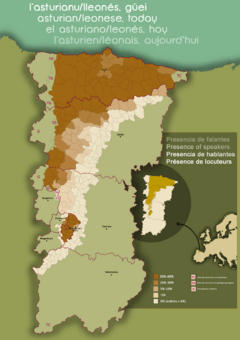Asturian language facts for kids
Quick facts for kids Asturian |
|
|---|---|
| Astur-Leonese asturianu |
|
| Native to | Spain |
| Region | Autonomous Community of Asturias |
| Native speakers | 110,000 (2007)e17 450,000 L2 speakers (1994) |
| Language family |
Indo-European
|
| Dialects | |
| Writing system | Latin |
| Official status | |
| Regulated by | Academy of the Asturian Language (Asturian) |
| Linguasphere | 51-AAA-ca |

Linguistic area of asturian language
|
|
The Asturian language (called asturianu by its speakers) is a special language spoken in Asturias, a region in northern Spain. It's the native language for many people there. Around 200,000 to 600,000 people speak it in Asturias.
This language is quite similar to the Leonese language, which is spoken in other parts of Spain that were once part of the old Kingdom of León. It's also similar to the Mirandes Language, spoken in a town called Miranda do Douro in Portugal. In Asturias, students in primary and secondary schools can choose to learn Asturian as part of their studies.
Contents
What is Asturian?
Asturian is a Romance language. This means it developed from Latin, just like Spanish, French, and Italian. It's part of a group called Astur-Leonese languages. These languages are spoken in different areas that were once part of the ancient Kingdom of León.
Where is Asturian Spoken?
The main place where Asturian is spoken is the Autonomous Community of Asturias in Spain. It's also related to other languages spoken in nearby areas. For example, Leonese is spoken in parts of León and Zamora. Mirandese is spoken in a small area of Portugal.
How Many People Speak Asturian?
It's a bit tricky to get an exact number. Some studies suggest that between 200,000 and 600,000 people speak Asturian. Many more people understand it, even if they don't speak it every day. There are also about 450,000 people who speak it as a second language.
History of Asturian
Asturian has a long history, going back to the Middle Ages. It grew from the Latin spoken by people in the Kingdom of Asturias and later the Kingdom of León. For a long time, it was mostly a spoken language.
Early Writings
The first known writings in Asturian appeared in the 10th century. These were not full books, but small notes or legal documents. One important document is the Fueru d'Avilés, a set of laws from the 12th century. It shows how the language was used in official ways.
Modern Asturian
In the 18th century, some important people started to care more about the Asturian language. One of them was Gaspar Melchor de Jovellanos, a famous jurist and writer. He believed it was important to study and protect the language. He even suggested creating an academy to do this.
The Asturian Academy
In 1981, the Academy of the Asturian Language was finally created. This academy works to study, protect, and promote the Asturian language. They create dictionaries, grammar rules, and encourage people to use the language. This helps keep Asturian alive and well.
Asturian in Education
In Asturias, students have the chance to learn Asturian in school. It's an optional subject in both primary and secondary education. This means that if students and their families want to, they can study the language and its culture. Learning Asturian helps young people connect with their heritage.
Sounds and Letters
Asturian uses the Latin alphabet, just like English and Spanish. However, it has some special sounds and letters that are unique to it.
Special Sounds
- The "h" sound: Sometimes, the letter 'h' in Asturian is pronounced like the 'h' in "hello" in English. This is different from Spanish, where 'h' is usually silent.
- The "ḷḷ" sound: This is a special sound, often called "che vaqueira." It's a bit like the 'l' sound but with a different tongue position. It's a very distinctive part of Asturian.
Images for kids
-
19th-century sketch of 17th-century author Antón de Marirreguera
-
Jurist and neoclassical author Gaspar Melchor de Jovellanos (1744–1811), who envisaged the Academy of the Asturian Language
See also
 In Spanish: Asturiano (asturleonés de Asturias) para niños
In Spanish: Asturiano (asturleonés de Asturias) para niños







